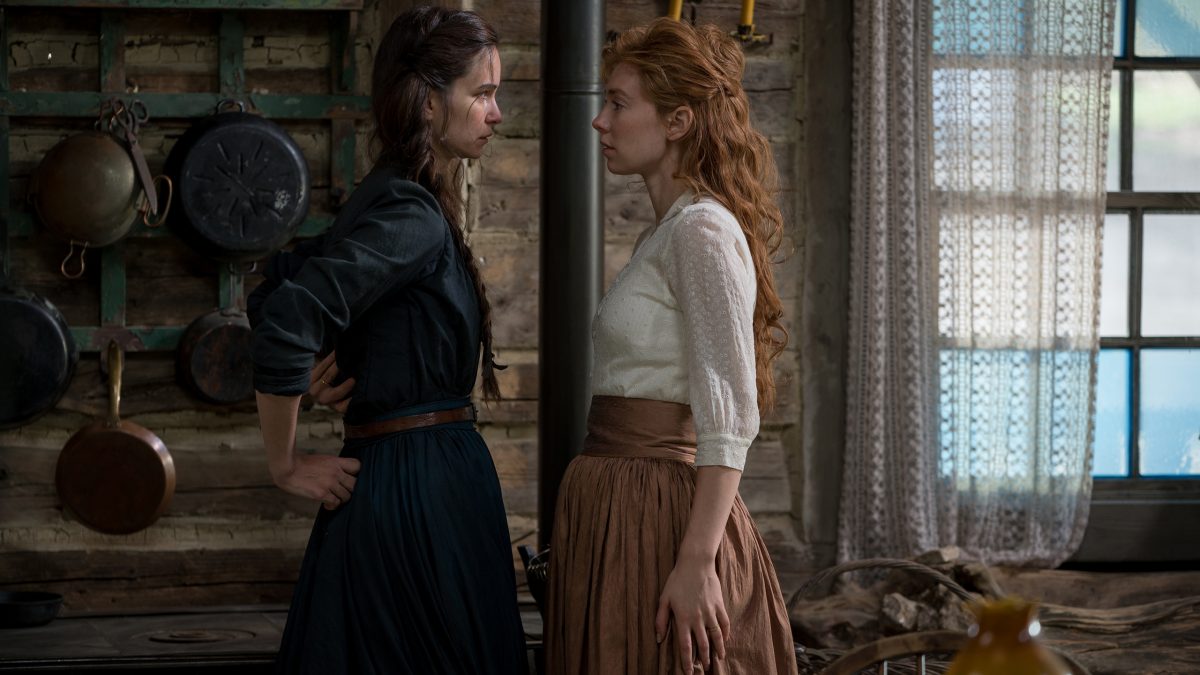Mona Fastvold’s “The World to Come” had its world premiere last year at the Venice Film Festival, where it won the Queer Lion for best LGBT-themed film. The film is ostensibly a romance. Somewhere in the 19th century on the American East Coast frontier, the wives of two landowners embark on a secret and tentative (and all too brief) romance. The romance between Abigail and Tallie is the fulcrum of the story. Abigail, as played by Katherine Waterston, is all quiet winces and reticent sadness, while Vanessa Kirby’s Tallie is all smouldering glances and sensuous energy. As both women struggle to maintain their relationships amidst differently unsatisfying marriages, the film investigates the limits of being a woman in the 19th century. That romance is central to it. And yet, the plaintive and tender “The World to Come” feels better understood not as an exploration of the romance that gives it life but more as a character-study examining the quiet desperation of the lonely Abigail.
It’s some time before we meet Tallie. Abigail is our entry-point to this story, and this is significant. Waterston’s voice arrives early in the film and recurs throughout, as her voice-over marks the overheard narration by way of diary entry that gives the film much of its structure. As “The World to Come” sharply pivots into its final act, there’s a succession of scenes where the narration becomes unsteady as it mimics Abigail’s frayed nerves. The seemingly perfunctory dates become frantic and as the narration goes through days in minutes, it calcifies the way that Fastvold’s interest in mining the perspective of this woman is key to figuring out the intention of the film’s engagement with queerness.
There are two key moments that confirm this. The first is a series of flashbacks in the film’s climax, and then the final moment of the film features a deliberate transformation spurred by Abigail’s mind. I’ve been thinking of those two moments since I saw the film at the Sundance Film Festival, and considering the ways that “The World to Come” both fits into recent depictions of lesbians on screen, and the way it unfolds beyond the familiar intentions that it suggests into some tougher and more complicated.
Queer romance filtered through the compulsory heteronormativity of society is not unusual. Both Abigail and Tallie are in unhappy marriages. Abigail’s marriage to the well-meaning, but uninspiring Dyer (an excellently modulated Casey Affleck) is stuck in ambivalence. It is not a terrible union but Abigail, who yearns for stimulation, feels trapped. That stimulation comes when Finney and Tallie, a new couple, arrive in the area. If Abigail’s marriage is bad, then Tallie’s is worse. Hewing close to Abigail’s perspective, we see little of the abuse at first. Instead, Fastvold’d suggests the unease before confronting us with it. Chris Abbott’s take on the very angry Finney is the film’s one weak-link – in characterisation and performance – but the slight garishness of his villain makes sense when considered as the true outlier in the relative calm of the frontier.
The middle portion of the film allows Waterston and Kirby to exist in each other’s space, providing a necessary warmth to offset the melancholy around it. In one of the most tender scenes the two women imagine a world where women were not trapped in marriages to survive and aren’t victims of the compulsory heterosexuality of their world. The moment does not feel like an anachronistic looking ahead but instead feels like an aching moment of clarity for queer women trapped in worlds that do not quite exist. And so, the ‘world to come’ of the film’s title is a distant dream. By the time the film’s harrowing climax comes, the expected tragedy feels inevitable.
What do we expect of a lesbian drama, though? The questions that have been asked of “The World to Come” — some more critical than others — feel pertinent. The pivot to a lesbian period romance amidst a continuing lack of contemporary lesbian figures on film is significant. Similarly, the ways that the historical version of lesbian media privilege white women is also cause for concern. “The World to Come” cannot exist outside of these questions and dynamics, although foisting the queries on this particular film feels ungenerous. Screenwriters Ron Hansen and Jim Shepherd adapt Shepherd’s short-story and manage to privilege this as a woman’s story, even as the film offers compelling presentations of how a marriage can break down, or continue, without romantic love
There’s a cunning unpredictability to the film’s engagements with the two couples as it invites and then rejects flattering readings of itself. Instead, this version of the film is one which recognises the complicated nature of love and commitment. That the romance at moments feels inchoate is a sign of the film’s own self reflexive way of mirroring Abigail’s consciousness. And it’s essential that this is filtered from Abigail. Waterston is the linchpin in the film, because of this. “The World to Come” plays to her ability in specific ways, internalising her grief at her, resentment at the world around and her growing desires in profound ways. She’s marvellous here and Andre Chemetoff’s cinematography recognises her face as the film’s best asset. That the film ultimately ends quietly and more sedate than one might anticipate makes sense when reconsidered as a tale about this quiet and sedate woman. But to look into Waterston’s eyes is to realise that the quietness does not mean mundanity. Without uttering a word, her final gaze in the film offers the promise of many better worlds to come.
The World to Come was screened at Sundance Film Festival as part of the Spotlight category. It is now available to view on Video on Demand.







